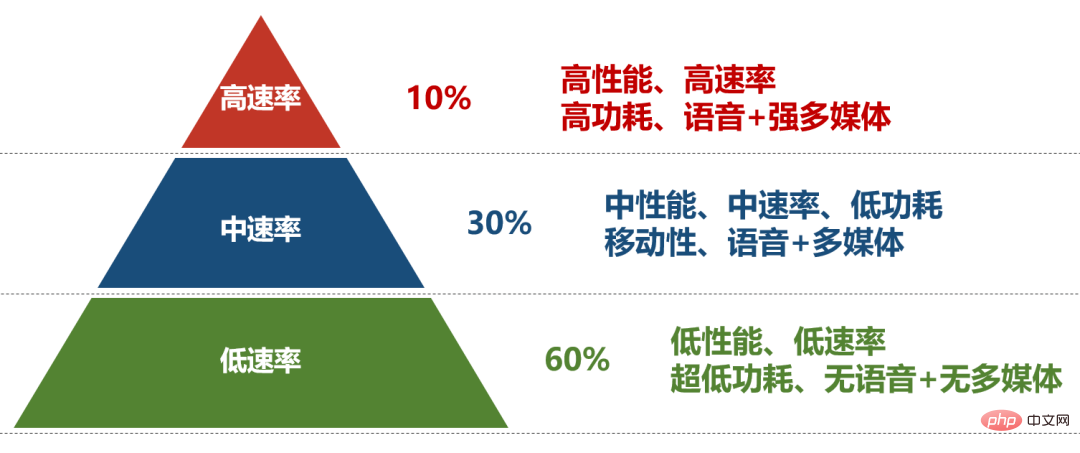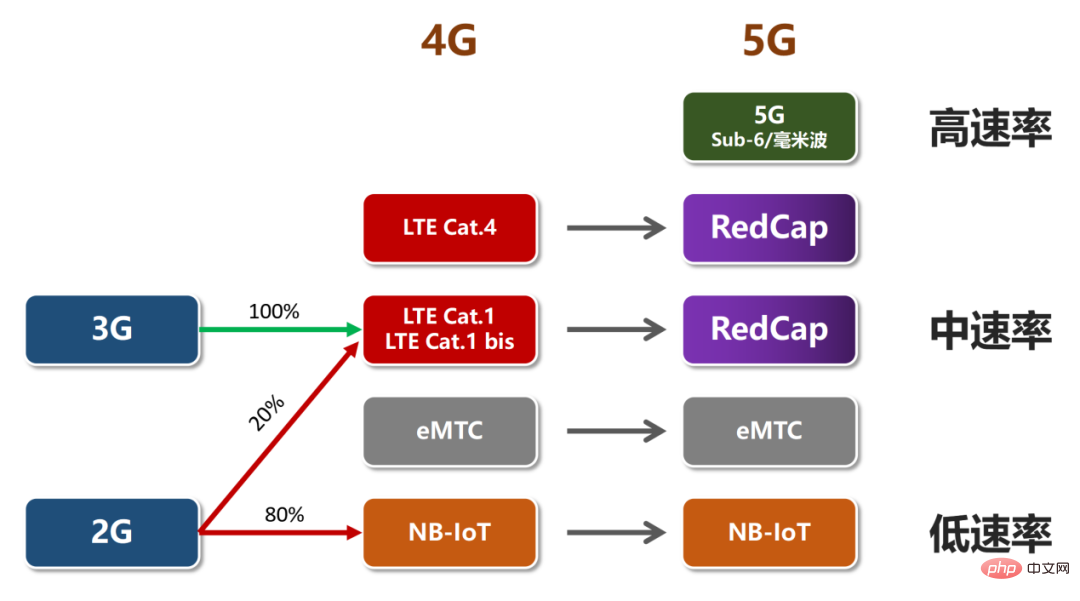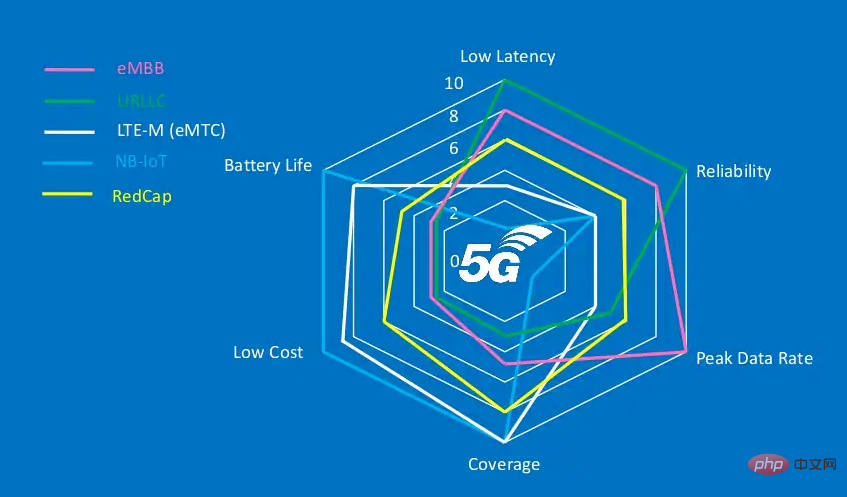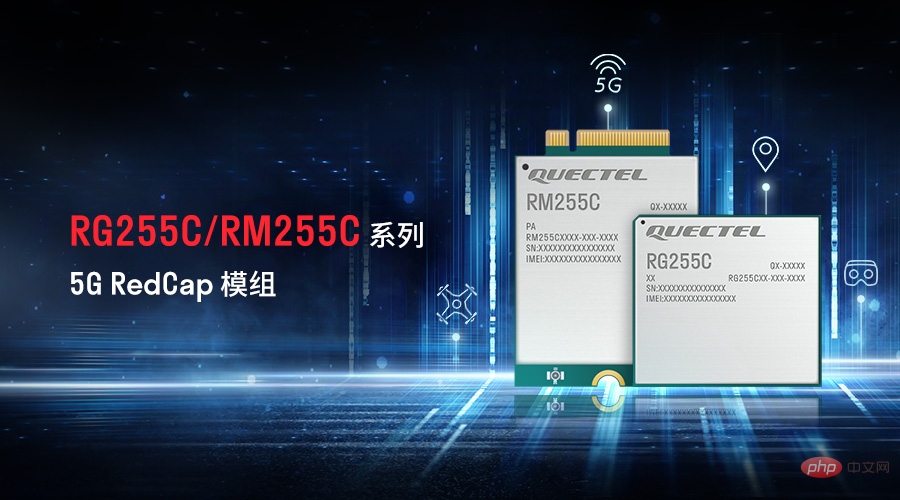Home >Technology peripherals >AI >Entering 2023, why is everyone starting to pay attention to RedCap?
Entering 2023, why is everyone starting to pay attention to RedCap?
- WBOYWBOYWBOYWBOYWBOYWBOYWBOYWBOYWBOYWBOYWBOYWBOYWBforward
- 2023-04-15 18:19:031528browse

In June last year, the 3GPP R17 version was announced to be frozen, which attracted the attention of the entire communications industry.
As we all know, as the current authoritative organization of global mobile communication standards, each release (Release) released by 3GPP points out the evolution direction of mobile communication technology and illuminates the way forward for the development of the entire industry.
In the R17 version, as a key 5G new technology specially researched, RedCap has attracted special attention and has been repeatedly reported by the media.
█ RedCap, what exactly is it?
RedCap, literally means "Little Red Riding Hood". But in fact, it is the abbreviation of Reduced Capability, which really means "reduced ability".
The so-called "reducing ability" is a relative concept. Its comparison object is 5G.
In other words, RedCap is a simplified version of 5G. It is a new technology standard formed by "cutting" some functions on the basis of 5G.
Previously, RedCap was not called its current name, but NR light (NR lite). As the name suggests, it is a lightweight version of 5G NR (New Radio). Therefore, the industry now also calls RedCap "lightweight 5G".
█ Why should we build a “lightweight 5G”?
After clarifying the definition of RedCap, you may ask: “Isn’t the stronger the performance of 5G, the better? Why should we build one instead? Simple configuration version, performance downgrade?"
Speaking of this, we need to first explain the technical system of the Internet of Things.
The concept of the Internet of Things was officially proposed in 1999.
The early Internet of Things technologies were mainly based on short-distance communication technologies such as Wi-Fi, Bluetooth, and NFC. At that time, although experts also tried to apply 2G technology to IoT scenarios, there was no progress because 2G performance was too lagging.
In the 3G/4G era, cellular communication technology has evolved rapidly and its performance has been greatly improved. As a result, long-distance IoT communications based on such technologies began to rise.
In 2016, 3GPP launched two important IoT technology standards, namely NB-IoT (Narrowband IoT) and eMTC (Enhanced Machine Type Communications).
These two technical standards are actually based on simplified versions of LTE. The speed is lower and the cost is lower, but more terminals can be connected at the same time. It is specially used in IoT scenarios. They have a collective name called LPWAN (Low Power Wide Area, Low Power Wide Area Network) technology.
In addition to NB-IoT and eMTC, LTE itself also has multiple user terminal categories (LTE UE-Category). Different categories have different rates. LTE Cat 1 is one of these categories. Its peak uplink rate is only 5Mbit/s, and it is also designed for the Internet of Things.
In the 5G era, designers have gone one step further, taking the Internet of Things as the main development scenario of 5G and proposing the grand goal of "Internet of Everything".
The three major application scenarios of 5G are eMBB (enhanced mobile broadband), uRLLC (low latency and highly reliable communication), and mMTC (massive IoT communication). They have their own emphasis on network speed, bandwidth capacity, coverage distance, spectrum efficiency, etc., and respectively serve segmented scenarios in vertical industry fields such as industrial manufacturing, transportation and logistics, medical education, and smart cities.
In the process of developing the Internet of Things, experts have discovered that the application scenarios of the Internet of Things are extremely complex. Different scenarios have different requirements for network indicators.
As a result, the industry has gradually subdivided IoT scenarios into three categories: high speed, medium speed and low speed:

Traditional high speed 5G cannot meet all the needs of the Internet of Things. Therefore, just as LTE will release NB-IoT and eMTC, 5G also needs to release a simplified version. So, there is RedCap.
According to the plan, with the withdrawal of 2G and 3G, most 2G and 3G IoT services will be migrated to LTE Cat 1, LTE Cat 4 and NB-IoT (eMTC should not be used in China ). In the future, LTE Cat 1 and Cat 4 requirements (that is, medium-speed and medium-high speed requirements) will gradually migrate to RedCap. RedCap will work with high-speed 5G to support the future development of the entire Internet of Things.

█ What are the technical features of RedCap?
RedCap is a technology that pursues a balance between performance, power consumption and cost.
Its performance is between eMBB and NB-IoT;
Its bandwidth rate is lower than eMBB, but much higher than LPWA;
Its power consumption And the cost is higher than LPWA, but much lower than eMBB.
This state of balance between speed, power consumption, and cost is suitable for many special IoT scenarios.

RedCap's capabilities are very "balanced" (the yellow line is RedCap)
We can analyze in detail how RedCap is streamlined.
First of all, RedCap’s spectrum bandwidth is smaller. In the Sub-6GHz band, RedCap’s bandwidth is 20MHz, which is smaller than the 100MHz of traditional 5G. 3GPP Release 18 is also planning further lightweight Redcap with a bandwidth of 5MHz.
Secondly, RedCap reduces the number of transmitting and receiving antennas and reduces the number of MIMO layers. For the Sub-6GHz frequency band, the receiving link of the RedCap terminal can be reduced to 1 or 2, and the corresponding downlink MIMO is reduced to layer 1 or layer 2 reception. In this way, the capability requirements for the terminal RF transceiver and baseband processing module are reduced.
Third, RedCap adopts a simpler modulation method, 64QAM, which also means that the requirements for radio frequency and baseband are greatly reduced.
Fourth, RedCap has introduced some power-saving methods, such as enhanced discontinuous reception features (eDRX) and longer sleep mode, allowing terminals to reduce power consumption and obtain higher battery life. .
Based on the above changes, it is predicted that the complexity of RedCap will be greatly reduced compared to 5G public network terminals. The costs on the baseband and radio frequency sides have also been significantly reduced.
It is particularly worth mentioning that RedCap can be introduced based on the smooth upgrade of the 5G existing network and does not require major transformation of the existing network. Based on the 5G system, RedCap can still implement enhanced functions such as 5G slicing, 5G LAN, high-precision timing, and uRLLC on demand to meet the needs of industry applications in different fields.
█ In what scenarios can RedCap be used?
3GPP officially gives three types of application scenarios for RedCap, namely: wearable devices, industrial sensors and video transmission.
Smart watch terminals are typical wearable devices. This kind of terminal does not have high speed requirements, but is very sensitive to power consumption, so it is suitable to use RedCap.
Industrial sensors belong to the industrial field. Commonly used types include temperature and humidity sensors, pressure sensors, motion sensors, accelerometers, drives, etc. The application scale of these sensor terminals is very large and does not have high requirements on speed and delay, but is sensitive to power consumption and cost.
Video transmission is familiar to everyone. It is divided into various categories. Some are high-end models (7.5-25 Mbps), 4K/8K ultra-high definition, and some are high-definition or standard definition, which are economical monitoring (2-4 Mbps). In practical applications, there are many economical monitoring applications, so RedCap is suitable.
In addition to the above scenarios, RedCap also has very broad development prospects in the fields of industrial control (industrial automation, intelligence), energy and power, and Internet of Vehicles.
These scenarios only require medium or low transmission rates, but there is a greater demand for 5G low-latency, high-reliability, network slicing, 5G LAN and other functions.
█ How is the industrialization of RedCap progressing?
RedCap is frozen in the 3GPP R17 version, which means that the standardization of RedCap has been completed.
However, it will take about 1-2 years from standard freezing to initial industrialization. Therefore, in the second half of last year, we did not see RedCap related products.
Now, entering 2023, RedCap’s industrialization has begun to accelerate.
On February 27, Quectel, a global IoT overall solution provider, officially released the 5G RedCap module-Rx255C series, including two versions: RG255C and RM255C.

This series of modules is based on Qualcomm Snapdragon® X35 5G modem and radio frequency system, complies with 3GPP R17 standards, and has superior wireless connection performance and low-latency communication capabilities.
The Rx255C series supports 5G standalone (SA) mode with a maximum bandwidth of 20MHz and a frequency bandwidth targeting all global markets. The module is also compatible with LTE networks, covering almost all mainstream operators around the world.
In terms of speed, this series of modules can achieve a theoretical peak downlink data rate of approximately 220 Mbps and an uplink data rate of approximately 100 Mbps, which is sufficient to meet the needs of IoT applications, such as robots, DTUs, and unmanned aerial vehicles. machines, smart ports, smart grids, AR/VR wearable devices, educational laptops and other medium-speed mobile broadband devices.
Based on the RedCap standard, Rx255C optimizes the number of antennas and transmit and receive bandwidth, and provides 64QAM/256QAM (optional) modulation, greatly optimizing cost and size. In addition, the high integration level and unique architecture of Snapdragon X35 can achieve low power consumption for module products, and can also help most new terminal categories obtain 5G functions.
In terms of function, the Rx255C series supports L1 L5 dual-frequency GNSS, which can provide precise positioning services for smart terminals. At the same time, in order to facilitate customer development, the module provides PCIe 2.0, USB 2.0 and other interfaces, as well as supplementary functions including VoLTE and DFOTA.
In order to help customers better design products, Quectel also provides a variety of supporting high-performance 5G antennas, which greatly improves wireless connection performance. Terminal manufacturers can bundle the Rx255C module with Quectel’s antenna and pre-certification services, thereby greatly reducing the overall cost of their products and shortening the time to market.
According to information disclosed by Quectel, they will provide engineering samples of RG255C series and RM2550C series modules in the first half of 2023 for customers to evaluate and test.
The release of RedCap module is a key step towards realizing the interconnection of everything in the 5G era. As Qian Penghe, CEO of Quectel, said: "Many IoT scenarios have low bandwidth requirements but are sensitive to cost and power consumption. The Rx255C series achieves a good balance between cost and performance and can target Solve the pain points faced by these industries in intelligent upgrades and support the large-scale deployment of 5G technology in more application fields."
█ Conclusion
Entering 2023, global digital transformation will set off a new wave. All walks of life will continue to strengthen the integration of ICT technology and their own industries, and explore the empowerment of their own traditional industries by digital technology.
Network connection technology represented by RedCap will accelerate this enabling process.
We look forward to the rapid maturity of RedCap’s ecosystem, and hope that the industry will launch more RedCap products and solutions as soon as possible to help the era of “all things intelligently connected” arrive as soon as possible!
The above is the detailed content of Entering 2023, why is everyone starting to pay attention to RedCap?. For more information, please follow other related articles on the PHP Chinese website!
Related articles
See more- Technology trends to watch in 2023
- How Artificial Intelligence is Bringing New Everyday Work to Data Center Teams
- Can artificial intelligence or automation solve the problem of low energy efficiency in buildings?
- OpenAI co-founder interviewed by Huang Renxun: GPT-4's reasoning capabilities have not yet reached expectations
- Microsoft's Bing surpasses Google in search traffic thanks to OpenAI technology

